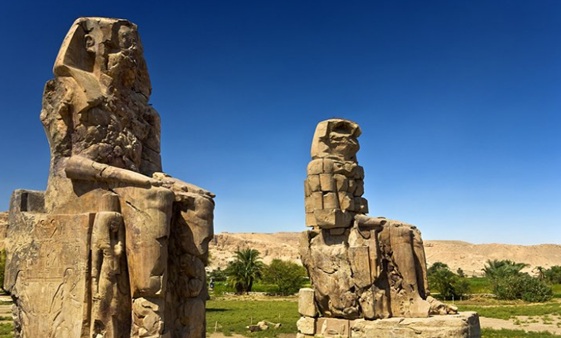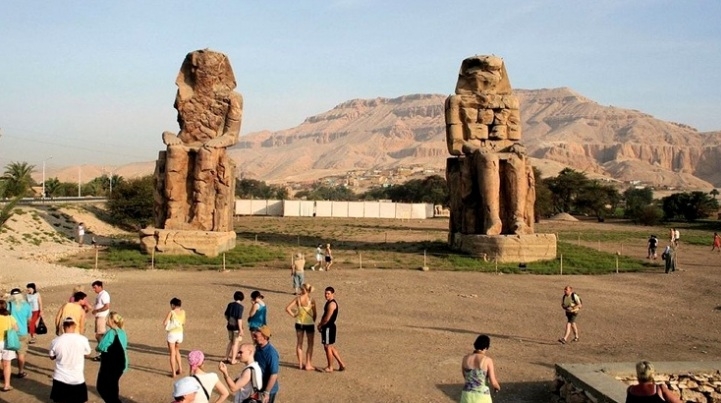Colossi of Memnon | Luxor, Egypt
On the vast, sunlit plains of Luxor’s West Bank, two towering figures rise from the sands, silent yet powerful, guardians of Egypt’s glorious past. These are the Colossi of Memnon — the magnificent twin statues that have watched over the ancient city of Thebes for more than 3,400 years.
They are among the most iconic landmarks in Egypt, representing the enduring legacy of Pharaoh Amenhotep III, one of the greatest rulers of the 18th Dynasty. Despite millennia of earthquakes, floods, and time’s erosion, the Colossi remain standing, embodying the strength and majesty of an empire that once ruled the ancient world.
For travelers, historians, and lovers of ancient art, the Colossi of Memnon are more than just stone figures — they are a gateway to Egypt’s eternal story.
The History Behind the Colossi of Memnon
The Colossi of Memnon were built around 1350 BC, during the reign of Pharaoh Amenhotep III, who ruled Egypt at the height of its wealth, peace, and artistic achievement. The statues originally stood at the entrance of his mortuary temple, a massive complex that once extended nearly half a kilometer along the Nile floodplain — the largest of its kind in Thebes.
Amenhotep III commissioned the temple to honor both his divine status and the god Amun-Ra, the supreme deity of the sun. It served as a spiritual and political statement — a place where the living could worship the pharaoh as a god and where his soul would be venerated after death.
Unfortunately, the temple did not survive the centuries. Repeated floods from the Nile and the later reuse of its stones by other rulers caused it to crumble. What remains today are the two immense statues that once marked its entrance — the Colossi of Memnon, immortalizing Amenhotep’s presence for eternity.
The Construction: Engineering of the Gods
Each of the Colossi stands about 18 meters (60 feet) high and weighs approximately 720 tons. Carved from single blocks of quartzite sandstone, the statues were transported all the way from quarries near Cairo, more than 675 kilometers (420 miles) away — an extraordinary engineering feat for the time.
How the ancient Egyptians managed to move such colossal stones remains one of archaeology’s enduring mysteries. It is believed they were floated down the Nile during the annual flood on massive barges, then hauled into position using wooden rollers, sledges, and manpower numbering in the thousands.
Once erected, the statues were placed to face east, greeting the rising sun each morning — a symbolic gesture of rebirth and divine renewal, central to Egyptian cosmology.
The attention to detail is extraordinary: Amenhotep III is depicted seated on a throne, his hands resting on his knees, wearing the royal headdress, the nemes, and the uraeus (cobra symbol) on his forehead — both marks of divine authority. His calm, regal expression captures the timeless confidence of a ruler who believed himself a living god.
.jpg)
Artistic Symbolism and Iconography
The Colossi are masterpieces of New Kingdom sculpture, blending idealism and realism. The pharaoh is portrayed not as a mortal man but as an eternal, divine being — serene, powerful, and unyielding.
On the sides of the statues are smaller carvings depicting figures from Amenhotep’s family:
-
Mutemwiya, his mother, symbolizing divine birth and royal lineage.
-
Tiye, his Great Royal Wife, one of the most influential queens of ancient Egypt.
-
His daughters and other divine figures, emphasizing the unity between the royal family and the gods.
Hieroglyphic inscriptions and decorative motifs once adorned the statues, proclaiming Amenhotep’s titles, achievements, and devotion to Amun-Ra. Time and erosion have worn away much of the detail, yet even in ruin, the craftsmanship and scale remain awe-inspiring.
The Legend of the “Singing Statues”
Perhaps the most fascinating chapter in the story of the Colossi of Memnon came after 27 BC, when a massive earthquake struck the region, toppling part of the northern statue. The cracks and fissures that formed produced an unexpected phenomenon: at dawn, the broken statue began to “sing.”
Visitors reported hearing a strange, musical sound — a hum, whistle, or vibration — emanating from the stone as the morning sun warmed its surface. The ancient Greeks and Romans, unable to explain the sound, attributed it to Memnon, a hero from Greek mythology, the son of Eos (the goddess of dawn).
According to legend, Memnon was slain during the Trojan War, and the sound was said to be his mother’s mourning cries greeting him at sunrise. From then on, the statues became known as the Colossi of Memnon.
Greco-Roman travelers, poets, and emperors — including Emperor Hadrian — journeyed to Thebes to hear the mysterious “voice of Memnon.” The phenomenon made the statues one of the earliest tourist attractions in the world, with ancient graffiti left by visitors still visible on the stone.
Interestingly, when the Roman Emperor Septimius Severus restored the damaged statue around 199 AD, the sound ceased forever — likely because the repairs sealed the cracks that caused the acoustic effect.

Archaeological Rediscovery and Excavations
For centuries, the Colossi stood as lonely sentinels in the desert, their temple buried beneath silt and sand. In the 19th and 20th centuries, archaeologists began uncovering the remnants of Amenhotep III’s mortuary temple.
Under the direction of Dr. Hourig Sourouzian and Dr. Rainer Stadelmann, excavations revealed that the site once featured a massive complex with dozens of statues, sphinxes, and courtyards. Many colossal figures of Amenhotep III were unearthed — some even larger than the standing Colossi — along with fragments of pillars, reliefs, and ceremonial pathways.
Today, the Colossi Restoration Project continues to preserve and study the site, aiming to reconstruct parts of the temple and safeguard the statues from environmental damage. The area remains an active archaeological zone, where new discoveries are still being made.
The Mortuary Temple of Amenhotep III
Though mostly ruined, the mortuary temple of Amenhotep III was one of the grandest architectural achievements of the New Kingdom. It once featured:
-
Vast courtyards and colonnades decorated with reliefs depicting the pharaoh’s divine nature.
-
Hundreds of statues representing gods, lions, sphinxes, and the king himself.
-
A massive peristyle court leading to sanctuaries where priests performed rituals for the king’s ka (spirit).
The temple complex was deliberately aligned with the Temple of Karnak across the Nile on the East Bank, symbolizing the eternal cycle of life, death, and rebirth — as the sun rose over Karnak and set behind Amenhotep’s temple.
Although floods destroyed most of the structure, it remains a vital part of Egypt’s architectural and spiritual legacy, representing the zenith of Theban culture.
The Colossi in Myth, Literature, and Art
Throughout history, the Colossi of Memnon have inspired poets, travelers, and artists from across the world. Ancient Greek historians such as Strabo and Pausanias described the “singing statues” in awe, while Roman visitors etched their names into the stone.
In later centuries, European explorers like Napoleon’s expedition team (1798) documented the statues in their famous Description de l'Égypte, introducing them to Western audiences as symbols of Egypt’s grandeur.
Even in modern times, the Colossi appear in literature, paintings, and photography as icons of timeless endurance — two figures who have witnessed the rise and fall of civilizations, yet remain unmoved.

The Site Today: Visiting the Colossi of Memnon
The Colossi stand prominently on Luxor’s West Bank, a short drive from the Nile and near several other major archaeological sites. Unlike many monuments that require tickets, the Colossi can be admired freely from the roadside, making them one of the most accessible ancient wonders in Egypt.
???? Location:
West Bank of Luxor, near the village of Kom el-Hetan, about 4 km from the Valley of the Kings.
???? Opening Hours:
Open 24 hours daily (best visited early morning or at sunset for soft light and cooler temperatures).
???? Entry Fee:
Free (public viewing area).
???? Getting There:
Visitors can reach the site easily by taxi, private guide, or organized tour from Luxor’s East Bank. Many West Bank day tours include stops at the Colossi, the Temple of Hatshepsut, and the Valley of the Kings.
???? Travel Tips:
-
Visit early to enjoy peaceful views before tour buses arrive.
-
Bring water, a hat, and sunscreen — the area offers little shade.
-
Combine your visit with other nearby attractions for a full West Bank experience.
-
Photography is allowed, and sunrise or sunset shots create spectacular contrasts on the statues’ surfaces.
The statues’ immense size is breathtaking up close. Even though they have stood for over three millennia, they still exude power and serenity, their gaze fixed eternally toward the east and the life-giving Nile.
.jpg)
Nearby Attractions
A visit to the Colossi of Memnon is just the beginning of exploring Luxor’s western treasures. Nearby are some of Egypt’s most remarkable ancient sites:
-
????️ Temple of Hatshepsut (Deir el-Bahari): A stunning mortuary temple built into the cliffs, dedicated to Egypt’s powerful female pharaoh.
-
???? Valley of the Kings: The royal necropolis where Tutankhamun and other New Kingdom pharaohs were laid to rest.
-
???? Ramesseum: The mortuary temple of Ramses II, filled with colossal statues and wall carvings celebrating his victories.
-
???? Medinet Habu: The best-preserved temple on the West Bank, built by Ramses III.
-
???? Deir el-Medina: The ancient village of the artisans who built the royal tombs — a glimpse into everyday life in pharaonic Egypt.
Together, these sites form a world-class open-air museum, offering visitors an unparalleled journey through Egypt’s golden age.
Preservation and Modern Efforts
While the Colossi of Memnon have stood the test of time, they continue to face challenges. Environmental factors — such as groundwater, flooding, and wind erosion — threaten their stability. Preservation teams, led by the Egyptian Ministry of Tourism and Antiquities in cooperation with international experts, are working tirelessly to monitor and protect the site.
Laser scanning, digital mapping, and 3D reconstruction are being used to document every detail of the statues, ensuring that their legacy will endure for future generations. Restoration projects also aim to reassemble fragments of the surrounding temple, slowly bringing back to life what was once one of Egypt’s greatest architectural marvels.
The Enduring Legacy of the Colossi
For over 3,000 years, the Colossi of Memnon have witnessed the ever-changing landscape of Egypt — from the glory of the pharaohs to the rise of empires, from ancient floods to modern tourism.
They have stood through earthquakes, Roman emperors, and modern excavations, yet they remain a symbol of endurance and divine kingship. Their faces, though weathered by time, still reflect the eternal calm of a god-king watching over his land.
These statues connect the past with the present, reminding every visitor that Egypt’s spirit is unbroken — carved not only in stone but in the soul of humanity.
Conclusion: The Eternal Guardians of Thebes
As the sun sets over the Theban hills, the Colossi of Memnon glow with golden light, their massive silhouettes casting long shadows over the desert plain. In that moment, time seems to dissolve — and the voice of history whispers through the silence.
The Colossi are not just remnants of the past; they are living witnesses to Egypt’s immortal story. They invite every traveler to pause, reflect, and feel the awe that generations before us have felt in their presence.
Visit the Colossi of Memnon — stand before Egypt’s timeless guardians, marvel at their ancient majesty, and experience the eternal voice of history in Luxor today!

